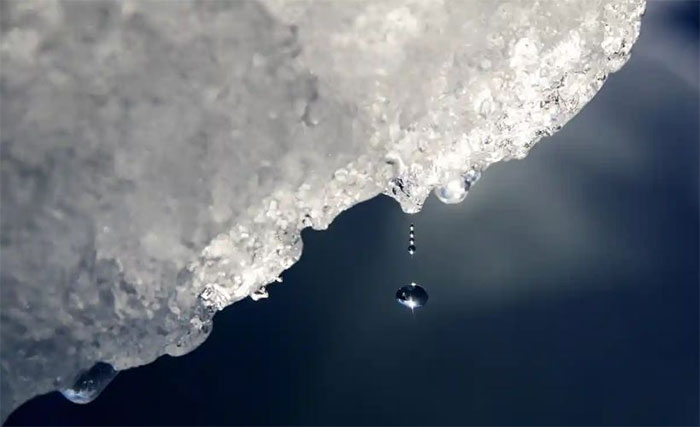Record heat waves appear at both poles of the Earth
Parts of Antarctica have risen by 40 degrees Celsius above normal, and at the same time, the Arctic has risen by more than 30 degrees Celsius.
The incredible heat waves that hit both poles of the Earth are worrying the climate science community. They warn this unprecedented phenomenon could be a sign that climate change is happening faster and more suddenly.

Melting ice in southwestern Greenland.
The Guardian reported that Antarctica's temperature set a record over the weekend, 40 degrees Celsius above normal. At the same time, weather stations near the North Pole were also seeing signs of melting ice, with some where the temperature is up to 30 degrees Celsius higher than normal.
At this time of year, Antarctica usually cools rapidly after summer, and the North Pole only slowly heats up as daylight lengthens after winter. For both poles, such simultaneous heating is unprecedented.
Last year, in the first chapter of a comprehensive review of climate science, the Intergovernmental Panel on Climate Change sounded the alarm about unprecedented warming signals - leading to some Changes such as melting in the Earth's polar regions - can quickly become irreversible.
Rated as a double hazard, heatwaves at the poles are a clear signal of the damage humanity is suffering on the climate. And melting ice could also cause further changes that accelerate climate change.
As the ice melts, especially in the Arctic, it reveals dark seas that absorb more heat and warm the planet even more. Meanwhile, most of the ice in Antarctica covers the land, so when it melts, it will raise sea levels.
Michael Mann, director of the Center for Earth System Science at Pennsylvania State University (USA), said extreme weather is exceeding predictions to a worrying level. He said: 'The models did a good job of predicting overall warming, but we argued that extreme events were exceeding the model's predictions. And we need urgent action."
Recent unprecedented weather patterns followed a series of alarming heat waves in 2021. By then, temperatures were approaching 50 degrees Celsius in the Pacific Northwest region. of the United States and Canada, resulting in hundreds of deaths.
An Antarctic weather station has beaten its historic record by recording a temperature of 15 degrees Celsius. Another coastal station that was frozen deep this time of year is now 7 degrees, the AP news agency said. C above freezing. Meanwhile, in the Arctic, some places rise to 50 degrees Celsius.
Scientist Walt Meier at the US National Snow and Ice Data Center said: 'The two poles are opposite places. You rarely see both the North and South poles melt at the same time. It was definitely an unusual incident'.
"I've never seen anything like this in Antarctica," said University of Colorado ice scientist Ted Scambos, who recently returned from a polar expedition.
- The decoding causes the record heat in Europe
- Tropical cyclones tend to shift toward the two poles
- Earth is hot record, but the next 5 years will be even hotter
- The two poles of the earth have the same species of creatures
- Washington Post: Vietnam suffers from unprecedented heat waves
- Australia record hot, the sea into a 'hot pot' cooked many creatures
- 2019 will be the hottest year in history: What weather hazards are we facing?
- Extreme heat waves threaten to trigger Australian fires again
- Hundreds of thousands of bats died from the hot sun in Australia
- China must go through the record hot and sunny August
- Too late to be able to prevent extreme heat waves
- Why is the heat getting worse day by day?
 Is the magnetic North Pole shift dangerous to humanity?
Is the magnetic North Pole shift dangerous to humanity? Washington legalizes the recycling of human bodies into fertilizer
Washington legalizes the recycling of human bodies into fertilizer Lightning stone - the mysterious guest
Lightning stone - the mysterious guest Stunned by the mysterious sunset, strange appearance
Stunned by the mysterious sunset, strange appearance